Kevin Qinghong Lin
UI-Vision: A Desktop-centric GUI Benchmark for Visual Perception and Interaction
Mar 19, 2025Abstract:Autonomous agents that navigate Graphical User Interfaces (GUIs) to automate tasks like document editing and file management can greatly enhance computer workflows. While existing research focuses on online settings, desktop environments, critical for many professional and everyday tasks, remain underexplored due to data collection challenges and licensing issues. We introduce UI-Vision, the first comprehensive, license-permissive benchmark for offline, fine-grained evaluation of computer use agents in real-world desktop environments. Unlike online benchmarks, UI-Vision provides: (i) dense, high-quality annotations of human demonstrations, including bounding boxes, UI labels, and action trajectories (clicks, drags, and keyboard inputs) across 83 software applications, and (ii) three fine-to-coarse grained tasks-Element Grounding, Layout Grounding, and Action Prediction-with well-defined metrics to rigorously evaluate agents' performance in desktop environments. Our evaluation reveals critical limitations in state-of-the-art models like UI-TARS-72B, including issues with understanding professional software, spatial reasoning, and complex actions like drag-and-drop. These findings highlight the challenges in developing fully autonomous computer use agents. By releasing UI-Vision as open-source, we aim to advance the development of more capable agents for real-world desktop tasks.
VideoMind: A Chain-of-LoRA Agent for Long Video Reasoning
Mar 17, 2025Abstract:Videos, with their unique temporal dimension, demand precise grounded understanding, where answers are directly linked to visual, interpretable evidence. Despite significant breakthroughs in reasoning capabilities within Large Language Models, multi-modal reasoning - especially for videos - remains unexplored. In this work, we introduce VideoMind, a novel video-language agent designed for temporal-grounded video understanding. VideoMind incorporates two key innovations: (i) We identify essential capabilities for video temporal reasoning and develop a role-based agentic workflow, including a planner for coordinating different roles, a grounder for temporal localization, a verifier to assess temporal interval accuracy, and an answerer for question-answering. (ii) To efficiently integrate these diverse roles, we propose a novel Chain-of-LoRA strategy, enabling seamless role-switching via lightweight LoRA adaptors while avoiding the overhead of multiple models, thus balancing efficiency and flexibility. Extensive experiments on 14 public benchmarks demonstrate that our agent achieves state-of-the-art performance on diverse video understanding tasks, including 3 on grounded video question-answering, 6 on video temporal grounding, and 5 on general video question-answering, underscoring its effectiveness in advancing video agent and long-form temporal reasoning.
VLog: Video-Language Models by Generative Retrieval of Narration Vocabulary
Mar 12, 2025Abstract:Human daily activities can be concisely narrated as sequences of routine events (e.g., turning off an alarm) in video streams, forming an event vocabulary. Motivated by this, we introduce VLog, a novel video understanding framework that define video narrations as vocabulary, going beyond the typical subword vocabularies in existing generative video-language models. Built on the lightweight language model GPT-2, VLog feature three key innovations: (i) A generative retrieval model, marrying language model's complex reasoning capabilities with contrastive retrieval's efficient similarity search. (ii) A hierarchical vocabulary derived from large-scale video narrations using our narration pair encoding algorithm, enabling efficient indexing of specific events (e.g., cutting a tomato) by identifying broader scenarios (e.g., kitchen) with expressive postfixes (e.g., by the left hand). (iii) A vocabulary update strategy leveraging generative models to extend the vocabulary for novel events encountered during inference. To validate our approach, we introduce VidCap-Eval, a development set requiring concise narrations with reasoning relationships (e.g., before and after). Experiments on EgoSchema, COIN, and HiREST further demonstrate the effectiveness of VLog, highlighting its ability to generate concise, contextually accurate, and efficient narrations, offering a novel perspective on video understanding. Codes are released at https://github.com/showlab/VLog.
ROICtrl: Boosting Instance Control for Visual Generation
Nov 27, 2024



Abstract:Natural language often struggles to accurately associate positional and attribute information with multiple instances, which limits current text-based visual generation models to simpler compositions featuring only a few dominant instances. To address this limitation, this work enhances diffusion models by introducing regional instance control, where each instance is governed by a bounding box paired with a free-form caption. Previous methods in this area typically rely on implicit position encoding or explicit attention masks to separate regions of interest (ROIs), resulting in either inaccurate coordinate injection or large computational overhead. Inspired by ROI-Align in object detection, we introduce a complementary operation called ROI-Unpool. Together, ROI-Align and ROI-Unpool enable explicit, efficient, and accurate ROI manipulation on high-resolution feature maps for visual generation. Building on ROI-Unpool, we propose ROICtrl, an adapter for pretrained diffusion models that enables precise regional instance control. ROICtrl is compatible with community-finetuned diffusion models, as well as with existing spatial-based add-ons (\eg, ControlNet, T2I-Adapter) and embedding-based add-ons (\eg, IP-Adapter, ED-LoRA), extending their applications to multi-instance generation. Experiments show that ROICtrl achieves superior performance in regional instance control while significantly reducing computational costs.
ShowUI: One Vision-Language-Action Model for GUI Visual Agent
Nov 26, 2024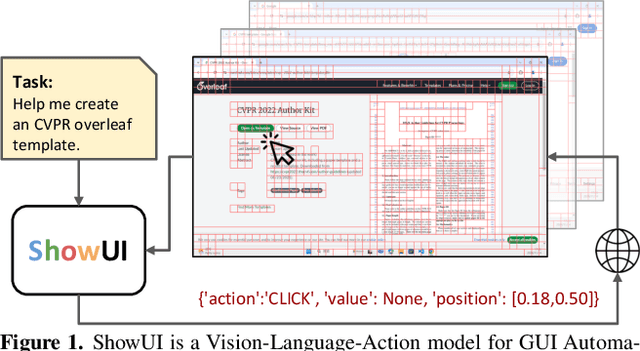
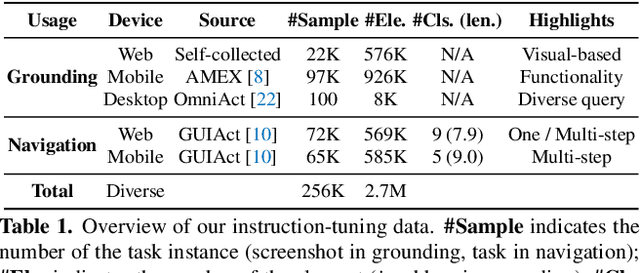
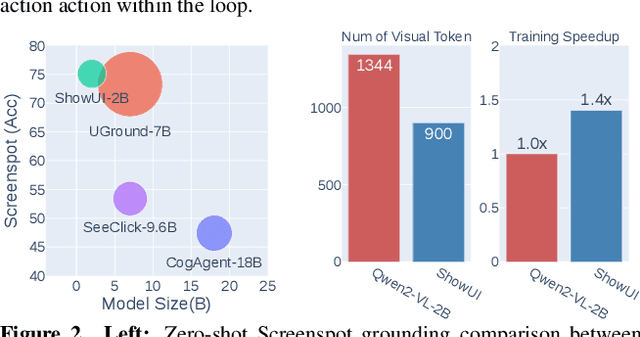
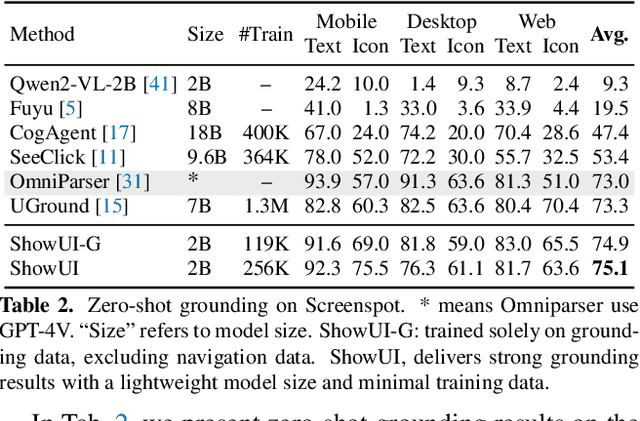
Abstract:Building Graphical User Interface (GUI) assistants holds significant promise for enhancing human workflow productivity. While most agents are language-based, relying on closed-source API with text-rich meta-information (e.g., HTML or accessibility tree), they show limitations in perceiving UI visuals as humans do, highlighting the need for GUI visual agents. In this work, we develop a vision-language-action model in digital world, namely ShowUI, which features the following innovations: (i) UI-Guided Visual Token Selection to reduce computational costs by formulating screenshots as an UI connected graph, adaptively identifying their redundant relationship and serve as the criteria for token selection during self-attention blocks; (ii) Interleaved Vision-Language-Action Streaming that flexibly unifies diverse needs within GUI tasks, enabling effective management of visual-action history in navigation or pairing multi-turn query-action sequences per screenshot to enhance training efficiency; (iii) Small-scale High-quality GUI Instruction-following Datasets by careful data curation and employing a resampling strategy to address significant data type imbalances. With above components, ShowUI, a lightweight 2B model using 256K data, achieves a strong 75.1% accuracy in zero-shot screenshot grounding. Its UI-guided token selection further reduces 33% of redundant visual tokens during training and speeds up the performance by 1.4x. Navigation experiments across web Mind2Web, mobile AITW, and online MiniWob environments further underscore the effectiveness and potential of our model in advancing GUI visual agents. The models are available at https://github.com/showlab/ShowUI.
MovieBench: A Hierarchical Movie Level Dataset for Long Video Generation
Nov 22, 2024



Abstract:Recent advancements in video generation models, like Stable Video Diffusion, show promising results, but primarily focus on short, single-scene videos. These models struggle with generating long videos that involve multiple scenes, coherent narratives, and consistent characters. Furthermore, there is no publicly available dataset tailored for the analysis, evaluation, and training of long video generation models. In this paper, we present MovieBench: A Hierarchical Movie-Level Dataset for Long Video Generation, which addresses these challenges by providing unique contributions: (1) movie-length videos featuring rich, coherent storylines and multi-scene narratives, (2) consistency of character appearance and audio across scenes, and (3) hierarchical data structure contains high-level movie information and detailed shot-level descriptions. Experiments demonstrate that MovieBench brings some new insights and challenges, such as maintaining character ID consistency across multiple scenes for various characters. The dataset will be public and continuously maintained, aiming to advance the field of long video generation. Data can be found at: https://weijiawu.github.io/MovieBench/.
VideoLLM-MoD: Efficient Video-Language Streaming with Mixture-of-Depths Vision Computation
Aug 29, 2024



Abstract:A well-known dilemma in large vision-language models (e.g., GPT-4, LLaVA) is that while increasing the number of vision tokens generally enhances visual understanding, it also significantly raises memory and computational costs, especially in long-term, dense video frame streaming scenarios. Although learnable approaches like Q-Former and Perceiver Resampler have been developed to reduce the vision token burden, they overlook the context causally modeled by LLMs (i.e., key-value cache), potentially leading to missed visual cues when addressing user queries. In this paper, we introduce a novel approach to reduce vision compute by leveraging redundant vision tokens "skipping layers" rather than decreasing the number of vision tokens. Our method, VideoLLM-MoD, is inspired by mixture-of-depths LLMs and addresses the challenge of numerous vision tokens in long-term or streaming video. Specifically, for each transformer layer, we learn to skip the computation for a high proportion (e.g., 80\%) of vision tokens, passing them directly to the next layer. This approach significantly enhances model efficiency, achieving approximately \textasciitilde42\% time and \textasciitilde30\% memory savings for the entire training. Moreover, our method reduces the computation in the context and avoid decreasing the vision tokens, thus preserving or even improving performance compared to the vanilla model. We conduct extensive experiments to demonstrate the effectiveness of VideoLLM-MoD, showing its state-of-the-art results on multiple benchmarks, including narration, forecasting, and summarization tasks in COIN, Ego4D, and Ego-Exo4D datasets.
Show-o: One Single Transformer to Unify Multimodal Understanding and Generation
Aug 22, 2024



Abstract:We present a unified transformer, i.e., Show-o, that unifies multimodal understanding and generation. Unlike fully autoregressive models, Show-o unifies autoregressive and (discrete) diffusion modeling to adaptively handle inputs and outputs of various and mixed modalities. The unified model flexibly supports a wide range of vision-language tasks including visual question-answering, text-to-image generation, text-guided inpainting/extrapolation, and mixed-modality generation. Across various benchmarks, it demonstrates comparable or superior performance to existing individual models with an equivalent or larger number of parameters tailored for understanding or generation. This significantly highlights its potential as a next-generation foundation model. Code and models are released at https://github.com/showlab/Show-o.
Learning Video Context as Interleaved Multimodal Sequences
Jul 31, 2024


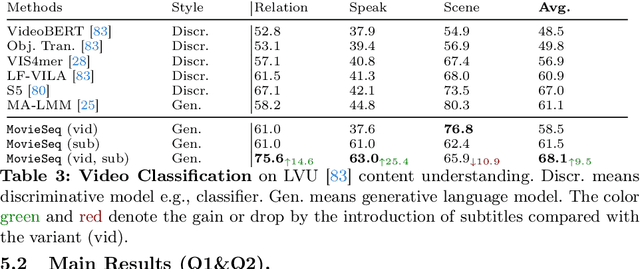
Abstract:Narrative videos, such as movies, pose significant challenges in video understanding due to their rich contexts (characters, dialogues, storylines) and diverse demands (identify who, relationship, and reason). In this paper, we introduce MovieSeq, a multimodal language model developed to address the wide range of challenges in understanding video contexts. Our core idea is to represent videos as interleaved multimodal sequences (including images, plots, videos, and subtitles), either by linking external knowledge databases or using offline models (such as whisper for subtitles). Through instruction-tuning, this approach empowers the language model to interact with videos using interleaved multimodal instructions. For example, instead of solely relying on video as input, we jointly provide character photos alongside their names and dialogues, allowing the model to associate these elements and generate more comprehensive responses. To demonstrate its effectiveness, we validate MovieSeq's performance on six datasets (LVU, MAD, Movienet, CMD, TVC, MovieQA) across five settings (video classification, audio description, video-text retrieval, video captioning, and video question-answering). The code will be public at https://github.com/showlab/MovieSeq.
GUI Action Narrator: Where and When Did That Action Take Place?
Jun 19, 2024



Abstract:The advent of Multimodal LLMs has significantly enhanced image OCR recognition capabilities, making GUI automation a viable reality for increasing efficiency in digital tasks. One fundamental aspect of developing a GUI automation system is understanding primitive GUI actions. This comprehension is crucial as it enables agents to learn from user demonstrations, an essential element of automation. To rigorously evaluate such capabilities, we developed a video captioning benchmark for GUI actions, comprising 4,189 diverse video captioning samples. This task presents unique challenges compared to natural scene video captioning: 1) GUI screenshots typically contain denser information than natural scenes, and 2) events within GUIs are subtler and occur more rapidly, requiring precise attention to the appropriate time span and spatial region for accurate understanding. To address these challenges, we introduce our GUI action dataset \textbf{Act2Cap} as well as a simple yet effective framework, \textbf{GUI Narrator}, for GUI video captioning that utilizes the cursor as a visual prompt to enhance the interpretation of high-resolution screenshots. Specifically, a cursor detector is trained on our dataset, and a multimodal LLM model with mechanisms for selecting keyframes and key regions generates the captions. Experimental results indicate that even for today's most advanced multimodal models, such as GPT-4o, the task remains highly challenging. Additionally, our evaluations show that our strategy effectively enhances model performance, whether integrated into the fine-tuning of open-source models or employed as a prompting strategy in closed-source models.
 Add to Chrome
Add to Chrome Add to Firefox
Add to Firefox Add to Edge
Add to Edge